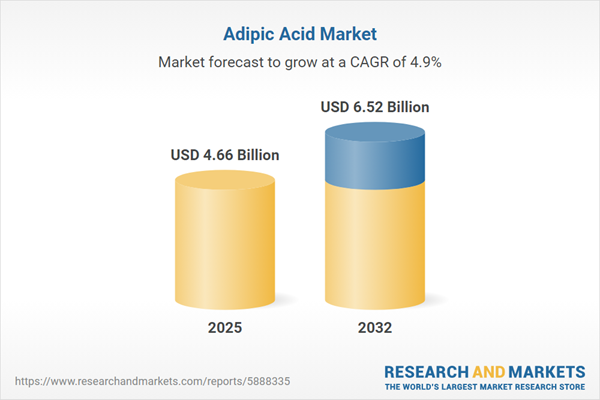Speak directly to the analyst to clarify any post sales queries you may have.
The adipic acid market is evolving as industry leaders respond to pressures in sustainability, regulatory demands, and modernized supply chain models. Proactive senior decision-makers can harness these shifts to drive value and resilience.
Adipic Acid Market Snapshot
The adipic acid market continues on a path of sustained growth, as reflected by recent size and CAGR projections that extend through 2032. Widely used as a core component in polymer synthesis, industrial coatings, and diverse specialty chemicals, adipic acid supports several manufacturing and production chains. The competitive landscape is shaped by the industry’s shift toward energy-efficient solutions and increasingly complex trade protocols. Companies that adapt to advancing sector standards tend to reinforce their positions, ensuring operational continuity and solidifying supply networks in a fluid market environment.
Scope & Segmentation
This in-depth market research delivers actionable segmentation insights and practical guidance for strategic decision-making:
- Applications: Adhesives and sealants, coatings, lubricants, engineering plastics, polymer films, textile fibers, plasticizers, polyurethanes, and food and beverage manufacturing. Relevant for innovation, investment allocation, and operational efficiency within varied production cycles.
- End Use Industries: Automotive, agriculture, construction, electronics, footwear, packaging, textiles. These sectors experience regulatory pressures and product innovation demands, fostering cross-sector partnerships and expanded value chain collaboration.
- Grades: Food-grade, industrial, and personal care standards. This classification assists executive teams in meeting global quality, safety, and compliance requirements.
- Production Processes: Bio-based and conventional petrochemical techniques. Adoption supports flexible sourcing strategies, improved sustainability, and regulatory adaptability.
- Distribution Channels: Direct sales, distributor networks, e-commerce. Each approach provides unique benefits for reach, agility, and effective compliance solutions as commercial dynamics shift.
- Regions/Countries: Americas, Europe, Middle East & Africa, Asia-Pacific with highlights for the United States, Germany, China, and Brazil. Enables precise regional risk mitigation, opportunity evaluation, and nuanced supply planning strategies.
- Key Companies: BASF SE, Koninklijke DSM N.V., Ascend Performance Materials LLC, Invista UK Holdings Limited. Examining the activities and partnerships of these entities informs robust benchmarking and fosters strategic alliances.
This segmentation framework equips leadership teams with context for decision making and regulatory readiness in markets defined by constant transformation.
Key Takeaways for Senior Leaders
- Combining procurement and R&D accelerates polymer solution development and stabilizes organizations in high-tempo end markets.
- Strategic investment in digital tools delivers expanded supply chain transparency, supporting agile responses to supply disruptions and changes in compliance frameworks.
- Comprehensive supplier assessment, coupled with fresh technology adoption, pushes sustainability programs forward and strengthens stakeholder confidence.
- Developing partnerships with academic and industry research entities sustains ongoing product innovation and supports seamless compliance upgrades.
- Expanding product grade portfolios ensures adaptable responses to local market requirements and competitive repositioning as sectors evolve.
- Facilitating integrated communication among procurement, regulatory, and operational teams enables consistent product quality and alignment with international standards.
Tariff Impact and Trade Dynamics
Updates to U.S. tariff policies impact companies sourcing adipic acid for use in polymers such as nylon, requiring systematic adjustment of sourcing approaches and logistics frameworks. Organizations are reinforcing their local procurement channels and maintaining frequent dialogue with regulatory authorities to enhance continuity, manage costs, and minimize supply vulnerabilities under ongoing global pressures.
Methodology & Data Sources
This report is based on layered research: direct interviews with executive leaders, expert consultations, and robust analysis of industry reports and publications. Such a methodology grounds the findings in current market realities and leadership perspectives, ensuring practical value for senior management.
Why This Report Matters
- Supports confident executive decisions with data-driven segmentation and targeted compliance insights.
- Guides investment in both technology and sustainability, advancing organizational stability and sectoral competitiveness as markets evolve.
- Delivers actionable intelligence by region and industry, enabling better risk management and informed market expansion strategies.
Conclusion
This analysis empowers senior executives with structured guidance, enabling effective procurement, regulatory strategies, and targeted market development in the changing adipic acid sector.
Additional Product Information:
- Purchase of this report includes 1 year online access with quarterly updates.
- This report can be updated on request. Please contact our Customer Experience team using the Ask a Question widget on our website.
Table of Contents
3. Executive Summary
4. Market Overview
7. Cumulative Impact of Artificial Intelligence 2025
Companies Mentioned
The companies profiled in this Adipic Acid market report include:- BASF SE
- Koninklijke DSM N.V.
- Ascend Performance Materials, LLC
- Invista UK Holdings Limited
- Asahi Kasei Corporation
- Sumitomo Chemical Co., Ltd.
- PTT Global Chemical Public Company Limited
- Sinopec Maoming Petrochemical Company Limited
- Mitsui Chemicals, Inc.
- UBE Industries, Ltd.
Table Information
| Report Attribute | Details |
|---|---|
| No. of Pages | 196 |
| Published | November 2025 |
| Forecast Period | 2025 - 2032 |
| Estimated Market Value ( USD | $ 4.66 Billion |
| Forecasted Market Value ( USD | $ 6.52 Billion |
| Compound Annual Growth Rate | 4.9% |
| Regions Covered | Global |
| No. of Companies Mentioned | 11 |









